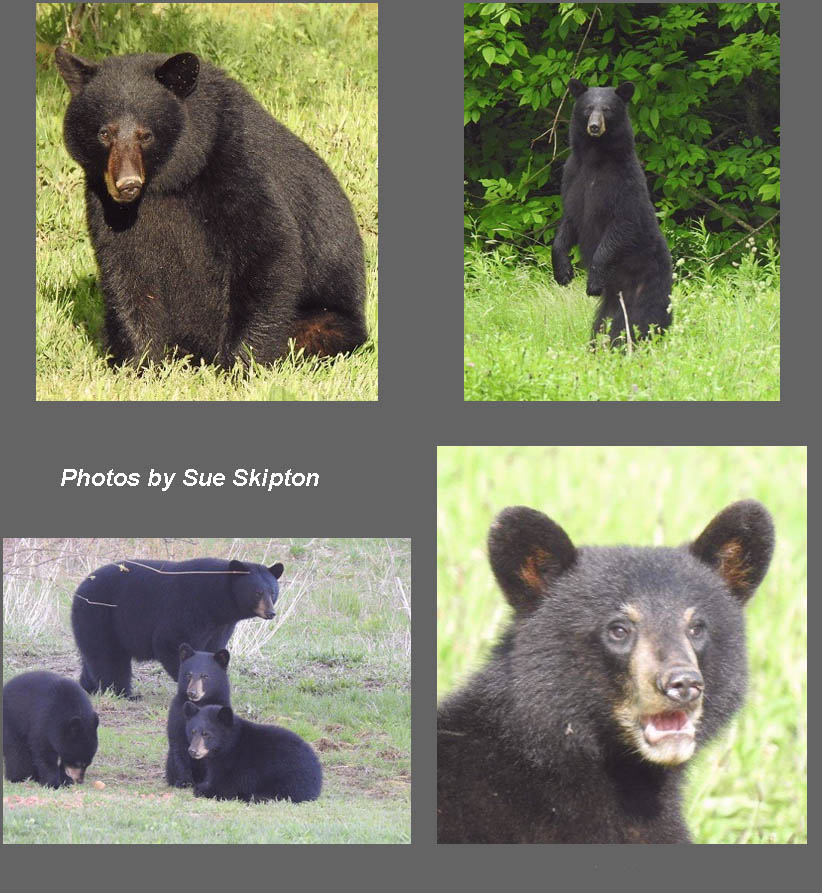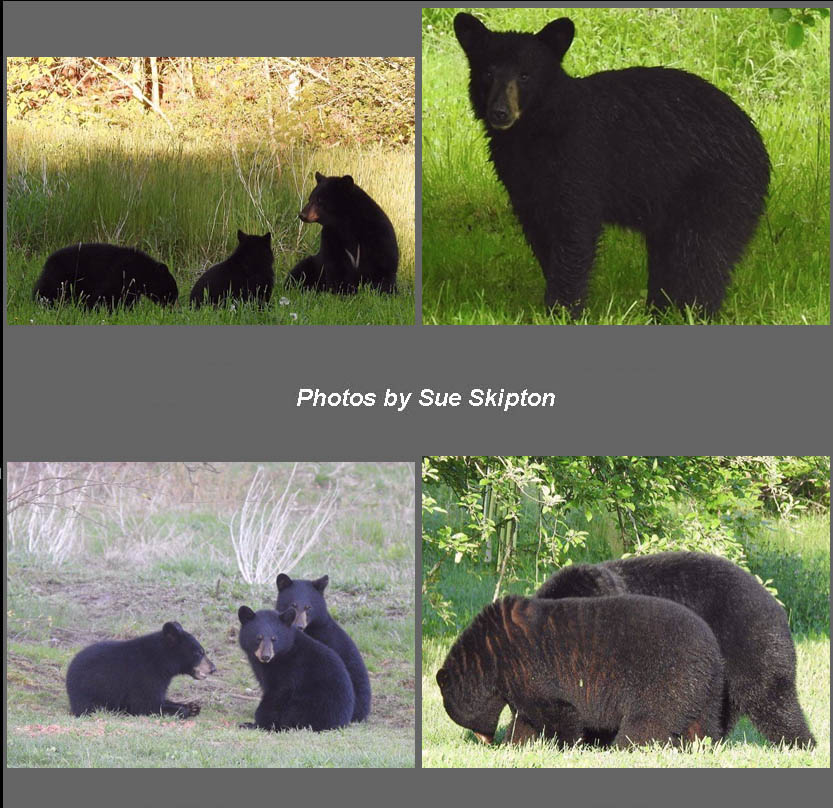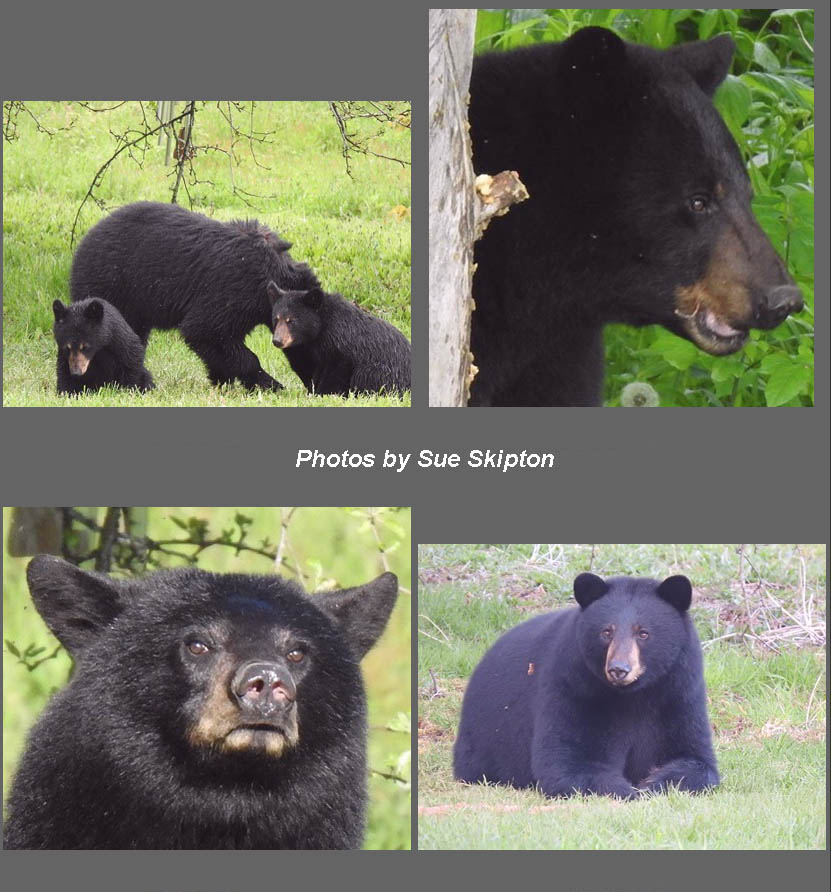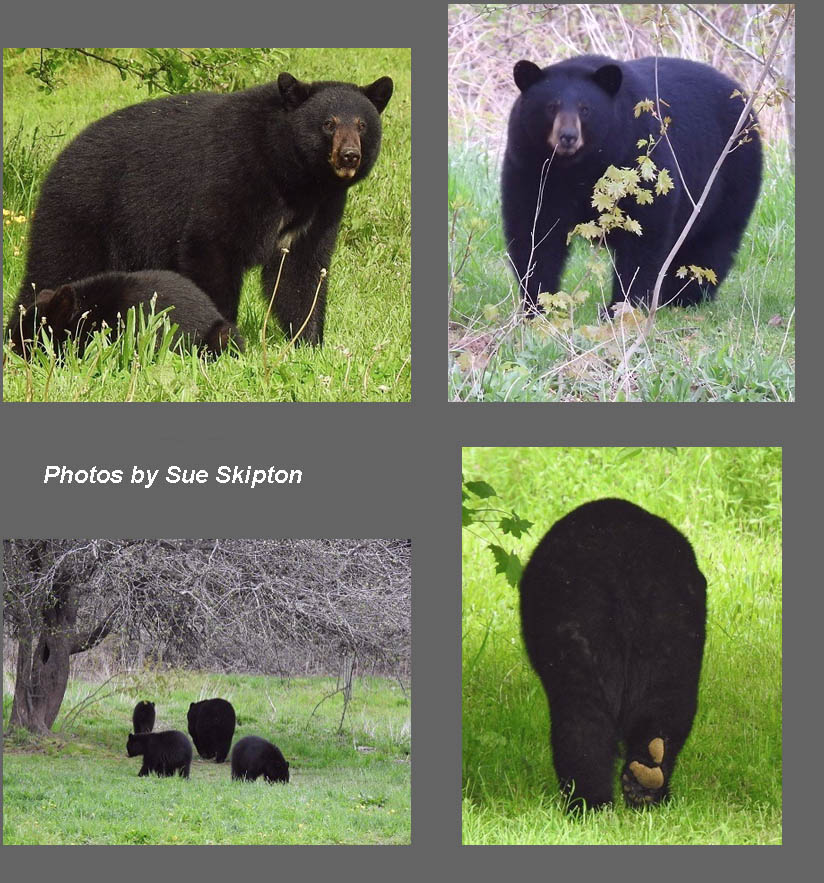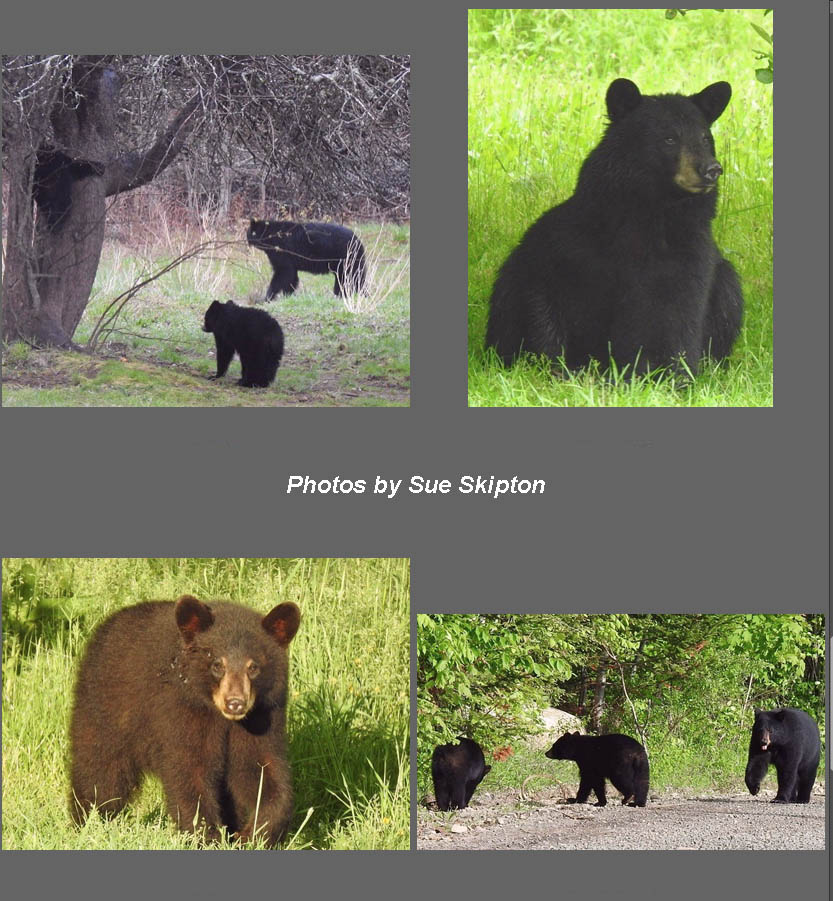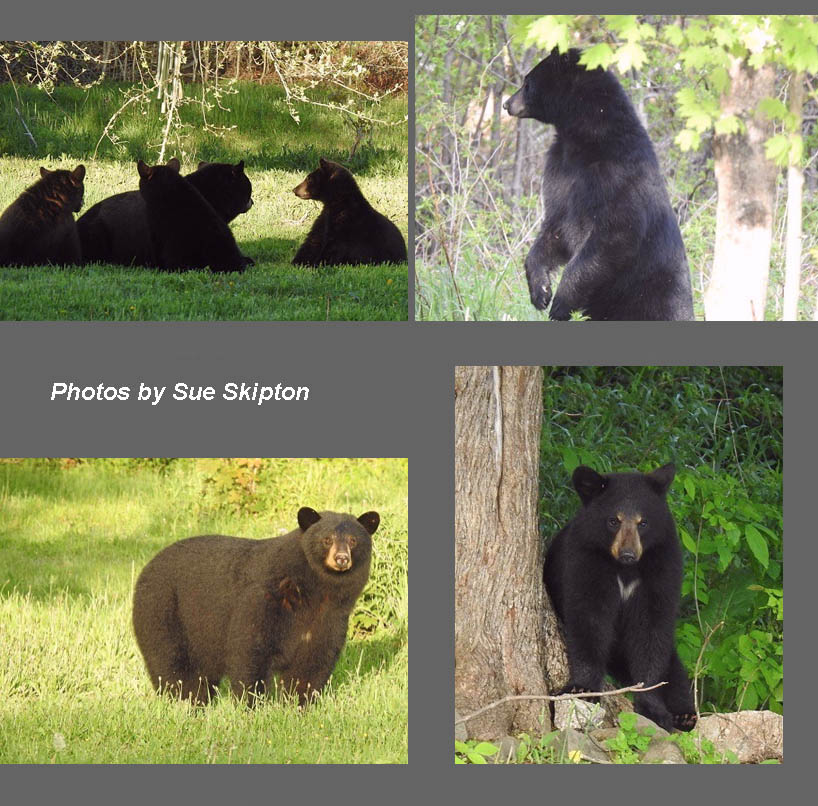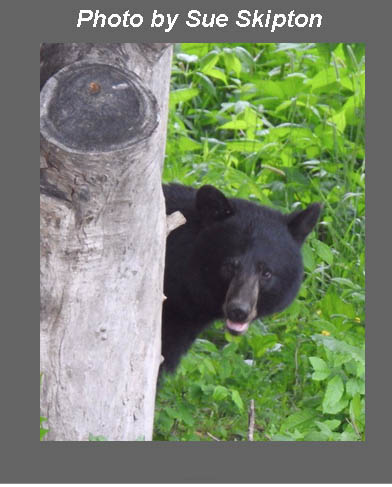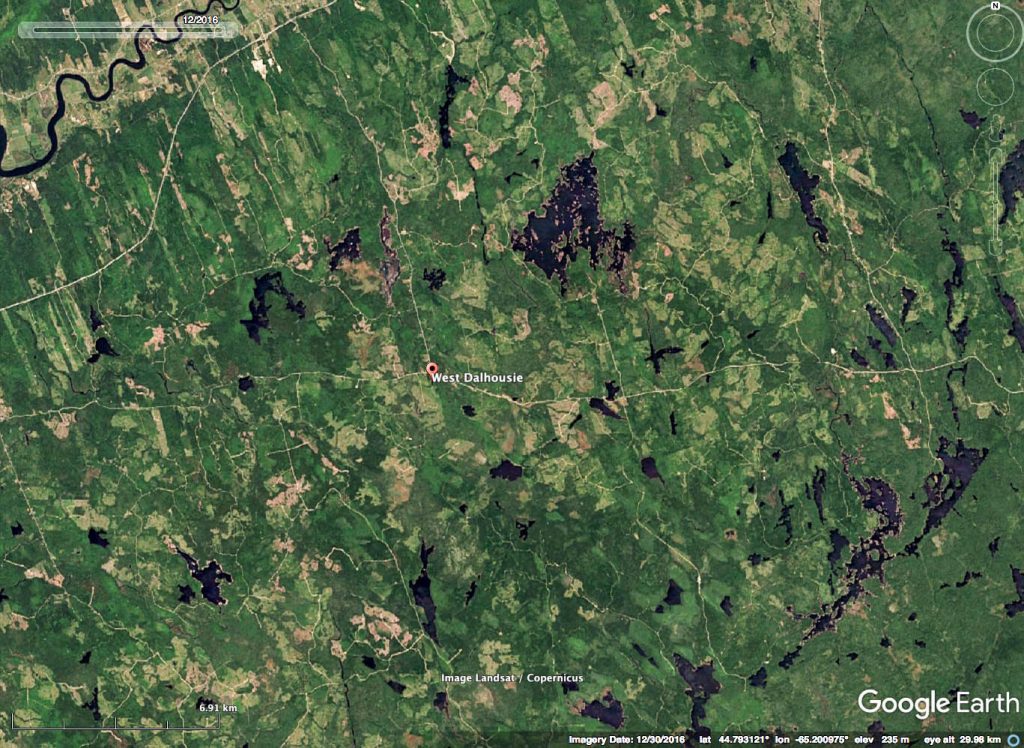Sue Skipton urges us to rethink how we perceive and live with these “human critters” in Nova Scotia
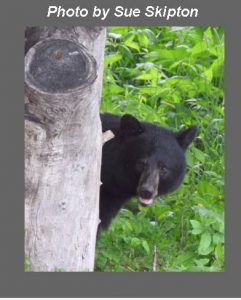 UPDATE: View Bear Necessities – Living with the bears no hardship for animal-loving West Dalhousie woman
UPDATE: View Bear Necessities – Living with the bears no hardship for animal-loving West Dalhousie woman
By Lawrence Powell for the Annapolis County Spectator, July 15, 2019
——–
Sue Skipton of West Dalhousie has frequently commented on Social Media about the bears who share the surrounding lands with her. She recently assembled a remarkable set of photos and videos that were posted on Woods and Waters Nova Scotia on July 2, 2019.
I asked Sue if I could copy the post and photos onto NSFN, to which she graciously agreed. I have added some of the lengthy discussion that occurred on WWNS, which was not always gracious; also a section with Some Articles & Websites and Research Literature on Black Bears
Thank you Sue S. for your care and respect for these bears and for sharing your concerns about disruption of their natural habitats and habits in Nova Scotia.
———–
Some of the 189 comments* on WWNS in response to Sue Skiptons original post there (July 2, 2019)
*As of 9:30 pm July 8, 2019
SueES to WWNS: Thank you for posting. As much as it is quite a thing to witness here, it saddens me why they are here. I have learned interesting things though, these guys are respectful of all other animals in my yard and myself. I had to do some fast learning on my part that we may all live in peace on the same property. Respect is a two way street and nature shows it best.
AR to SueES:
your pictures of these beautiful creatures and their calmness really helps ease my anxiety about when we share their land behind your house in the summer. Camping, kayaking fishing. So much breathtaking beauty in that forrest. Heartbreaking to see and hear about the destruction:(
CS: I was wondering about that Sue, if they were a problem to you or not. They do look very calm in the photos but I wondered if it made your backyard off limits to you.
AR to SueES: saddens you they re here?To me it indicates that bears are thriving and in fact in my opinion the bear population is exploding, hardly saddens me other than lack of proper bear management.
Sue ES to CS: … they actually don’t limit me no, but it is a situation that you are aware of and you tend to look before you jump out to do things is all.
AR – I do not feel they are exploding in population, I feel they are being seen more in populated areas due to loss of habitat. So it is the old, gosh there are so many bears, they will have to do something about it, look they are everywhere. We are just seeing them more as they have to find a place to go. 1300 + Hectares being cut behind me when it used to be a full forest, that is a lot of territory that they lived in , gone now.
SH to SueES: Sue ES, what you feel vs. fact is a huge difference. In the case of black bears, your feelings are largely misplaced. Take Keji Seaside for example. Closed for the long weekend due to increased bear activity. Know why? Because conditions are optimum for them in many areas of Nova Scotia, leading to increased numbers. Your area of the province is no exception. Bears are thriving there and reproducing well because a side effect of the cuts in your area is, in fact, the creation of prime bear habitat.
JPS: I don’t feel it was coincidence that bears moved into the subdivision in New Minas at the same time that land was cleared for the new interchange!
SueES to SH: I can tell that it doesn’t matter the timeline that is presented, you will in no way shape or form admit that forestry might be to blame. I do know very much about the black bear and even understand their reproduction as well. If you can not see a clear timeline here then I guess you might be part of the problem. They have 64 acres here, they now have their homes here of which I have already acknowledged. They didn’t use to be here, they didn’t come here til the BIG CUTTING. As far as clear cuts or cutting supplying them out here, well takes up to five years for anything to start to grow here after being demolished. I have watched it over and over and over. Not to mention that spraying has been done down the back as well. So Forgive me for saying but you are growling up the wrong tree here as I have been documenting all here for the duration of my time here. I am NOT against Forestry and I think that is where people get me wrong. I am NOT against good ecological , sustainable forestry which can benefit foresters, wildlife, and all that grows in a forest. What is happening is none of that and the plant life in a forest is dying, the animals are moving out, the water being destroyed by such forestry as is going on now. I may be just a small heartbeat in all that is going on but even the professionals that are dealing with forest issues say the same. You Foresters can have your cake and eat it too if we make a swift move from the disasters of today and move to a better, more ecological for all involved , sustainable type of forestry. This type of forestry will not only increase the dollar in your pocket but provide for all that is needed from wood, it would increase the dollar value for years to come. AT the rate forestry is being done now, when it is done it is done and will be years before you can depend on a WORTHY MONEY CROP. Changes made to forestry now will benefit you and many others in the long run for years to come but Forestry Industry just does NOT want to listen to that.
JPS: I don’t feel it was coincidence that bears moved into the subdivision in New Minas at the same time that land was cleared for the new interchange!
SM: Sue ES Thanks for the respect you show for these beautiful animals.
MLC: That is very sad they are losing their habitat. They are huge. I would be so afraid of them…poor creatures…but good they have a safe haven. I hope they are not too close to your house.
Sue ES: They are within 100 ft actually. Also , all hours of the day. I can tell you that I really have no problem with them. I had to do some learning for sure. I do live in the forest, way back in the forest. Always pays to be aware and prepared.
RBT: Apparently they manifested out of thin air and are there to pray for Jesus. Why, there may be a piece of burned toast or pizza with his image on it attracting them.
Chances are it’s the fact there are few people guys thing bears now and the population has exploded. Coupled with simpletons who leave food out because they think bears can pray and talk to them ,this is what you get. Just time before one of them is attacked.
Too bad barely anyone squealing clear cut clear cut didnt know how to search for the relevant information about the recent population increase among all species not just bears.
SueES: I am glad you guys all think that, however there has ALWAYS been food here, that was explained, not only is there food here for the cats which I put out and the BEARS don’t bother with, there are apple trees, pear trees, raspberries, blueberries, black berries and many other things bears like here for the past 16 years. The Bears did not arrive en masse until the big cuts happened down back. So think what you will and there will always be deniers of what is happening. I really wish this would be understood.
SH to Sue ES: it would have to be extremely bad cat food or very well protected to have that many bears around and they don’t touch it or so everything they can to get at it. They are creatures of opportunity and it’s being readily provided. You’ve got one raiding garbage bags and yet they won’t touch cat food? Doesn’t seem even remotely likely.
SueES: haha, mischief is mischief, the two bags they took, one had coffee grounds in it, the other was a bag of rinsed out catfood cans. Both of which were not ripped up, although I have had the can bag ripped up and watched the cubs play with the cans. Please tell me what it is you DON’T understand about Bear Cubs and their playfulness. Every adolescent animal both wild and domestic can have their times, just like younger children do. I have had my garbage taken approx twice a season each season. I pick it up and put it right back where it came from. I have had the bear cubs take my EMPTY green bin and play in it. The cat food here is not sheltered at all as a matter of fact it is right out in the open , same place , same time, same kind for 16 years.
SueES to SH:.. they do live here, thank you. I do not photograph that area, that is their space and I respect that. They have actually quite a large area with favorite climbing trees, den , flattened down well lived in area…
RBT: Call DNR for providing a dangerous hazard to the public. Imagine if a few kids walk by there eating candy.
SueES: DNR knows what is going on here in its entirety. I am not in a place that children pass by, I live in the middle of the forest here that all is being destroyed around me. Conservation officers are also aware. FYI
GL: The south woods out there is disgusting now after all the clear cutting… the landscape of the woods I grew up exploring has changed dramatically in just a few years… pushing a lot of animals out and into encounters with humans.
BS: Huge clearcut happened on West Dalhousie road in May, 50 acres mowed in 2 weeks. Many bear and deer sightings on the road since.
GO-J: The bears need some where to go.We have a lot of them at my place.We have a juvenile that has no fear of humans. DNR will trap and kill them,they don’t relocate them any more.They are losing their homes and becoming to use to humans……. so very sad.
SueES: Black Bears are really a lot like people. They respect which is a lot more than I can say for a part of the human race. Dr. Lynn Rogers has a very good article and study on Black Bears. They can live with humans quite nicely, they do get used to people but in his study, they do not become dependent on people. I strive to make sure that they also live as much a natural life as they are used to. They have a whole play /den area down back of these pictures of which I do not share to the public. It is their place and I respect that.
Some of the discussion posts on a post on WWNS (July 6, 2019) about this post
SH Some “good” cherry picked comments from that entire thread. The black bear population in Nova Scotia is thriving and could be considered a success story, actually. The West Dalhousie bear story appears to still be lacking some important details. Those very healthy well fed bears are not hanging around simply because of forestry work. It’s just not in their nature. I visit West Dalhousie area frequently to go fishing and I can tell you, despite any ongoing forestry operations, there is abundant prime bear habitat and natural food sources to be found.
AR: Look wish you d stop trying to correlate increased bear interactions with humans with deforestation,that’s your opinion and what do you know about what good bear habitat is?I do,I also know that it’s happening all over this province.No deforestation in my area and lots of bears ,it’s more like a thriving population that is exploding which will be more detrimental to them ,management needs to happen like a spring hunt .I don’t like our clear cutting practises either but in the end it will actually create better habitat for them with the new growth of grasses,berries,bull rushes are a favorite nutritional food Aswell….Logging companies do not clearcut just because it is the most economical way to harvest timber. … Clearcutting increases the biological diversity of the forest, which enhances habitat for a variety of wildlife. Some species of wildlife actually thrive better in brushy thickets of seedlings and small saplings.”
AR: SL off course there are, but there are impacts on all species when one alters an environment.,The better question is,is it good or is it detrimental to said species?Two hundred sixty five acres clear cut and replanted in mixed hardwood and spruce where I hunt ,previous was a good population of deer and bear,after huge increase in both species as the upcoming growth and browse provided much more sustenance hence the increased carrying capacity there to provide food naturally means increased reproduction ,simple!To suggest that bears have moved into the suburbs because they got no trees left is absurd,bears have to eat voraciously till denning,since they re “moved” into the burbs where they sleep in winter the shed?Lets be honest here it Doesn t take a rocket scientist to see your only trying to appeal to the emotions of the readers here as opposed to basing your assumptions on actuall facts.
DGP: So clearcutting is creating an excess of certain types of food, after ? 5 years? And during that first 5 years? And what about denning habitat? We do not have the data to be able to say whether or not bears have increased- or whether we are just seeing more. It could well be that numbers have increased, but higher numbers do not necessarily equate to improved well-being and ecological balance, e.g., bald eagles are ‘doing well’ number-wise in NS, in part because of feeding them in the valley, but it has created many ecological imbalances…”Clearcutting increases the biological diversity of the forest, which enhances habitat for a variety of wildlife.” Yes that is true for example, for Massachusetts (where mature forest predominates) but not for NS, the Lahey Report makes that clear.
AR to DGP: lol yeah sure!…fter clear cutting the forest floor is immediately opened up to the growth of grasses,berry yielding bushes etc,more food means greater carrying capacity for the bears which in nature equates to more offspring.Ive spent my life in this area and I can tell you it’s much greater than just sightings lol.Common sense should tell you we re seeing more at an alarming rate because there are more.”sues bears” are enjoying the food she has provided unmolested therefore why wouldn’t they visit regularly .You could say it’s a form of baiting and ultimately its teaching those Cubs that humans are not to be feared setting up possibly a confrontation in the future.The area she is,I’m very well familiar with great habitat for bears.useing bears as a pawn to promote anti clear cutting is the wrong approach jus say n.
DGP to AR: Ok, by the same logic, to promote clearcutting because it benefits bears is also “the wrong approach”. I agree it’s possible that the extensive clearcutting in NS has resulted in increased numbers of bears but that is not nec. a ‘good thing” or for that matter a ‘bad thing’. To establish either would need a good deal of study. There is a lot of anecdotal evidence, some of it on these discussion threads, that the immediate effect of clearcutting is to disrupt the bears (and other wildlife) and they move to other places (“clearcut refugees”) …as available; to the extent it isn’t they end up in towns or die off… and very likely are under a lot of stress. I see Sue Skipton’s comments as more about how we view and interact with bears and other wildlife as beings rather than about clearcutting per se, they are comments to pause and think about.
SH to DGP: two things: Firstly, I’ve yet to see a comment on here promoting clear cutting because it is good for bears. I have, however, seen Sue’s comments where she clearly says area the bears in her yard are there as a direct result of losing their homes and food sources. Simply not true. It’s a blatant attempt to garner sympathy and support for her crusade against clear cutting in general. I see comments about “nonsense” being “spewed” by the forest harvesters; this nonsense about West Dalhousie bears is the exact same tactic…
AR to DGP am in no way promoting clear cutting at all in fact I’m not a fan,my bone to pick is useing bears increased interactions with humans CAUSED BY CLEARCUTTing .Got that?Your AGENDA if you and your group want credibility don’t twist what I’ve said ,nough said here .Ive experienced over fifty years of spending a lot of time in the natural world here and “my data” is very relevant.
DGP to AR I guess it’s a matter of balance isn’t it? The balance right now in NS by pretty well any measure is highly skewed on the clear-cut side. I guess (?) we agree on that. I would like to see comments by recognized experts on whether the immediate effect of clearcutting is to drive bears out of an area (even if they come back in later years to feed); that seems to be one of issues and could in fact cause “increased interactions with humans” in the short term even if the longer term effect is ‘beneficial’ to the bears. What Sue Skipton said was: “For the first 11 years Bowater owned the land behind me and DNR used to bring the nuisance bears out here all those years and drop them off. There has ALWAYS been food around my property as I rescue Feral Cats here and have Racoons too. However, 4.5 years ago when Crown took over Bowater and started cutting the 900+ Hectares behind me, the bears started moving out and yes, into my yard”. She is talking about new cuts, less than 5 years old, next to her property and the coincidence of that with increased presence of bears on her property. Is that inference really so outlandish?
AR to DGP: dnr /goverment need to have a spring hunt .We re not the only province experiencing huge growths in bear populations .Atleast every other province with a bear population has one.Even Ontario with growing population only harvests via hunters four percent of what they believe to be the required amount to keep a balance.This province seems to rely on harvest number percentages of bear license holders and public sentiment to set their policy.I suggest if they want more”honest” data they should eliminate the bear/deer rifle season overlap,you can draw your own conclusion to what I’m saying.
DGP to AR: I am a bit slow. “I suggest if they want more”honest” data they should eliminate the bear/deer rifle season overlap, you can draw your own conclusion to what I’m saying.” – can you elaborate? btw I grew up in a hunting culture, and hunted (guns and spear-fishing) until I was about 30 (40+ years ago) but I recognize that with loss of natural predators, it can play important conservation roles.
SG to DGP: , it is when you consider the bears could have moved in any direction away from recent clear cuts. There are lots of cuts in that area that are multi aged and provide habitat. I know not for sure, but I suspect it is readily available food being provided that is drawing bears to her property and the reason why they stay. Any bear hunter can provide you with tons of personal experiences about how bears are opportunistic feeders, and once a steady food source is established and the bears have found it they don’t go far. Oh yeah, and of course a complete clear cut will have an immediate impact on any animals that were in that area. That is a given. Common sense tells us all that. No expert need weigh in to prove it.
DGP to SH: x I figured no expert needed to weigh in. Re: “lots of cuts in that area that are multi aged and provide habitat”, yes; but poss/prob already well occupied… so they move onto her property, which explains the increase concurrent with the clearcutting…so I do not see a contradiction here.
SH to DGP: , okay, I’m going to say it outright. Sue can call me out on it if she likes. I have zero doubts that she is, in fact, feeding those bears on her property. They are staying put because she has given them reason to stay. Period. Using them to promote her anti clear cutting agenda is wrong!!! She has zero proof that clear cutting has anything to do with what those bears are doing. It’s her feelings mixed with presumptions being used to garner sympathy for her narrative. Underhanded tactic, at best…
WWNS: So much for “the experts not weighing in.” As for this being a “group”, W&WNS is me, myself and I – that’s it! W&WNS is a forum for information exchange and respectful dialogue. Anyone is allowed to participate so long as the ground rules are followed. The goal of this page is to effect positive change, to be educational and thought provoking, reflective and introspective by celebrating the traditions, natural beauty, and intrinsic values of our woods and waters while decrying the calculated, self-gratifying attitudes, doctrines and practices that wantonly destroy and pollute the land, poison the water and foul the air in the name of progress and pursuit of the omnipotent dollar. PS. The “bears” have attracted more than 36,000 views to date.
DGP: Some thoughts as I try to separate what’s actually going on with the bears (rather than with critics on each side of the clearcutting debate):
– SH, AR could be right that overall the clearcutting has increased the abundance of bears; there is lots of literature to support such a contention. However, L&F Minister Rankin has stated that “There’s no compelling reason from a conservation perspective [for a spring hunt].The numbers have been consistent. The population remains consistent.” See Nova Scotia once again rejects plea by hunters for spring bear hunt Jean Laroche · CBC News Apr 12, 2019 . https://www.cbc.ca/…/bear-hunt-spring-politics-1.5094541. (L&F should make their observations on bear numbers public)
– At the same time, SS could be right that it was the nearby clearcuts, now less than 5 years old, that resulted in the increased visits by bears on her property; she is not alone in reporting, anecdotally, increased abundance of bears on or close to residential properties, immediately following clearcuts. It takes a about 5 years after a clearcut for high berry production etc. to set in (longer if herbicides are used, or there is a lot of damage by clearcutting) so perhaps she will see a decline in a few years as those same lands start producing a lot of fruits, ants etc. (It’s also possible that bear populations are increasing because of clearcutting more broadly in Anna Co, but with all the more desirable habitat now taken, homeless bears are moving into new habitat, as has occurred in some parts of the USA – see Black Bears Are Rebounding—What Does That Mean For People, National geographic articles June 26, 2015..https://news.nationalgeographic.com/…/150626-black…/
In regard to whether clearcutting is good or bad in relation to bears specifically: it’s possible that we have an excess of bears in relation to ‘what’s natural’ for NS. Such is the conclusion in regard to black bears in intensively logged boreal forest in Quebec, where clearcutting has stimulated bear populations which “poses great concern for conservation, especially for forest-dwelling woodland caribou”- V Brodeur et al., 2008. –https://www.nrcresearchpress.com/doi/full/10.1139/Z08-118..We don’t have caribou today of course (but did when the first settlers arrived and they were present in C.B until the 1920s),but there could be negative impacts on other ungulates (deer, moose). In the case of the intensively logged boreal forest, the authors comment “Restoration of the natural forest structure by less intensive forest management and preservation of large mature to old-growth stands (Bergeron 2004) would limit the influence of logging on black bear habitat quality….The implementation of uneven-aged forestry practices in future forestry planning should contribute to lessen the effect of logging on habitat quality by maintaining natural stand attributes and favouring regeneration processes (Bergeron 2004).” So the implementation of uneven-aged forestry practices in future forestry for NS as recommended by the Lahey Report may be just what’s needed to solve ‘the bear problem’!
AR: The numbers? You mean the hunter success rate ratio?Flawed science at the very least ,many hunters carry a bear license without any intent unless forced to shoot bear,it’s an issue that I believe could be solved by not overlapping the bear /deer rifle season.
SH to DGP: so you address most of the issues, but ignore the evidence that SS is, in fact, feeding those bears and they have no reason to leave. I had 18 different bears frequenting one bait site during hunting season last year. Most were not from the immediate area. Once drawn in, and I kept the food source consistent, most of those bears stayed in the vicinity of the site. They, like the West Dalhousie bears, had no reason to leave…
DGP: I haven’t seen your evidence that “that SS is, in fact, feeding those bears”; she does state that “my yard … really is a haven for them as there are apple and pear trees, blackberries, blueberries, raspberries and so much more , which have always been here since I moved here.”
SH to DGP: David Graham Patriquin , which currently are not producing a single iota of food for those bears. They don’t sit around patiently waiting for trees and berry bushes to bear fruit. (Pun intended). Watch her videos. Pay attention to what the bears are doing. They are not feeding on any naturally occurring food source. I challenge her to post on here and state unequivocally that she is not feeding those bears on a regular basis. To experienced people who do feed bears on a regular basis, all of the observed behaviours we have seen many times are being exhibited by those bears, but “her” bears are different.
DGP: Well that remains an inference, not proof. Ok you are skeptical, but leave it at that. As for the ‘anti-clearcut conspiracy’, I think that one has been pretty well settled by the Lahey Report, but it goes on anyway which understandably raises the ire of a Iot of people and that is what they are expressing. I appreciate after reading reams of papers over the last few days – and reading your comments and those of others minus the rhetoric – that there are many factors influencing bear numbers and health and impacts that you can’t apply one story to all, there is a lot that is very site or region-specific; I am only doing my best to get some grasp on it, state my understanding and engage in some constructive dialog as poss.
AR to DGP: let me put it this way.If you saw the bears consistently going to same spot and willing to defend it,scooping up and chewing there something other than grass,which could be ate anywhere.The kicker,if I had bears in my yard not one would be made “welcome”.That in of itself is very very detrimental to the bears in regard to teaching them not to fear humans especially around residences that have visits from unsuspecting folks.To me this is dangerous and if anyone got injured because of this could be some legal jeapordy.
DGP to AR: I assume, SS is aware of poss. dangerous behaviour and respects them appropriately or she would already be a casualty. I am a marine biologist by training, years ago worked in shark infested waters at a time when people really feared them; I had one uncomfortable close encounter, many innocuous ones. Attitudes have changed; there is still a healthy respect, but more sensitivity and less fear. To me, that is SS’s message. I don’t think she is suggesting we all hug a bear – or feed them.
AR to DGP: so the danger is about attitude?If she respected them appropriately as you assume she wouldn’t be feeding them ,Aswell a mother and Cubs presents an inherent danger to those that may encounter them,in fact any bear!Why can’t you just say what’s obvious here since you understand that each animal has behaviour patterns .
DGP: Respectfully, I think we have gone about as far as we can with this conversation and I will bow out at this point… it was helpful to illustrate different perspectives and to me to sort out a few things and perhaps make me more observant. On motives, I think we should not be too judgmental, either way. At the core, we all want to see healthy, diverse wildlife in NS
————–
Some Articles & Websites and Research Literature on Black Bears
Old-growth logging leaves black bears without dens: biologist
Sarah Cox May 27, 2019 in the Narwhal. “B.C. protects beaver lodges and occupied migratory bird nests, but there are no regulations protecting black bear dens in most parts of the province. On Vancouver Island, dens are vanishing along with old-growth forests. Meet biologist Helen Davis, who is on a mission to make sure female bears and their cubs have homes”
Black bear activity raises concern in Inverness County
Erin Pottie in Cape Breton Post. Jul 21, 2018. Cape Breton residents may be seeing increased black bear sightings this year due to some late spring frosts that damaged berries and vegetation.
Cape Mabou resident Mary Campbell said she started experiencing problems with the furry omnivores around late April…Campbell believes some of today’s problems with bears relate to clearcutting in places such as her home community. “The only explanation I can give is the bears are either being driven out of their natural habitat or bears are becoming so familiar with people they’re not afraid,” she said.”
| BLACK BEARS AS ANT-EATERS: seasonal associations between bear myrmecophagy and ant ecology in north-central Minnesota Karen V. Noyce et al., Can. J. Zool. Vol. 75, 1997 pp 1671-1686 |
A “clearcut” case? Brown bear selection of coarse woody debris and carpenter ants on clearcuts
Shane C. Frank et al., 2015. Forest Ecology and Management 348: 164–173. On brown bears but many refs to black bears having similar habits. “Clearcuts appeared to increase the occurrence of a relatively important summer food item, the carpenter ant, on Swedish managed forests for the brown bear. However, the potential benefit of this increase can only be determined from a better understanding of the seasonal and interannual variation of the availability and use of other important brown bear food items, berries (e.g. Vaccinium myrtillus and Empetrum spp.), as well as other primary needs for bears (e.g. secure habitat and denning habitat), within the landscape mosaic of managed forests.”
American Black Bear Conservation Action Plan
Michael R. Pelton et al. 1999. In: C. Servheen, S. Herrero, and B. Peyton (eds). Bears. Status survey and conservation action plan. pp: 144-146. IUCN/SSC Bear and Polar Bear Specialist Groups. IUCN, Gland,
Switzerland and Cambridge, UK.
BAD NEWS BEARS
Written by Rita Frost, October 27th, 2015. On www.dogwoodalliance.org. “Black bears all over the Southeastern United States are threatened by an ever-increasing and destructive biomass industry that is converting whole forests into pellets for European electricity.”
Black Bears Live Near You – Bear Facts
NS Department of Lands and Forestry
The Environmental Consequences of FOREST FRAGMENTATION in the Western Maine Mountains
Janet McMahon, 2018. Maine Mountain Collaborative Occasional Paper No. 2.
Use of Clearcut Habitats by Black Bears in the Pacific Northwest
KR Barber, Graduate thesis. 1983. “Bears selected for clearcuts (5-21 years of age) over all other vegetation types for feeding but preferred areas dominated by large trees when inactive during both the day and night.”
| Sue Skipton’s perspectives of bears, independently acquired through her living close to them, have a lot in common with those of Lynn Rogers, a well known bear researcher and founder of the North American Bear Center.
North American Bear Center Managing northern forests for black bears |

Wrote SueES to WWNS:
“Those are my words on one of my bear photos when someone said he looked like he was praying.” The text on the photo reads “Please bless this Human Critter who keeps watch over me every day and hope the loggers and politicians don’t take her away. These terrible organizations have taken my home. I have no where left to roam. This human critter lets me be here. She speaks softly, a voice I love to hear. Amen
Habitat selection by black bears in an intensively logged boreal forest
V Brodeur et al., 2008. “Extensive logging of the boreal forest rejuvenates landscapes once dominated by old-growth stands. As black bear (Ursus americanus Pallas, 1780) fitness and behavior are known to be primarily related to the abundance of shade-intolerant soft mast species in northern forests, we hypothesized that logging will influence habitat and space use patterns of black bears. We used VHF telemetry on 12 female black bears in the Réserve faunique des Laurentides (Quebec, Canada) to investigate seasonal patterns of habitat selection in an exploited heterogeneous boreal landscape at different spatial scales. Habitat characterization based on seven forest cover types allowed us to compare the productivity of key forage species in various post-logging age classes. Regenerating stands (6–20 years old) had the uppermost ground vegetation cover, providing both the highest density and a high biomass of berries. Black bears preferred regenerating stands (6–20 years old) and avoided mature coniferous forests inside their home range. Home-range size was inversely related to the proportion of regenerating stands (6–20 years old). Intensive logging influenced black bear habitat and space use patterns, and presumably their population dynamics. An increase in the habitat quality of an opportunistic predator poses great concern for conservation, especially for forest-dwelling woodland caribou (Rangifer tarandus caribou (Gmelin, 1788)).” From the text: “Den sites were located in post-perturbation (0–20 years) forest covers in a proportion of 33% (n = 21), and in mature forests (>50 years) in a proportion of 67%. Taking into account habitat availability, females preferred to establish their den under mature forest covers (G = 10.5, p < 0.05)…By planning forestry with broad-scale even-aged silviculture, our industry has created a favourable habitat for the black bear. Its habitat selection, home-range size, and territoriality were influenced by the distribution and abundance of soft mast shade-intolerant species. The accepted view that bear habitat quality is greater in old stands (Litvaitis 2001) does not hold true in northern coniferous forests as Open regeneration stages take on a capital importance. Restoration of the natural forest structure by less intensive forest management and preservation of large mature to old-growth stands (Bergeron 2004) would limit the influence of logging on black bear habitat quality….The implementation of uneven-aged forestry practices in future forestry planning should contribute to lessen the effect of logging on habitat quality by maintaining natural stand attributes and favouring regeneration processes (Bergeron 2004).”
Disentangling Woodland Caribou Movements in Response to Clearcuts and Roads across Temporal Scales
David Beauchesne et al., 2013. PLOS ONE. “We showed that woodland caribou modify their fine-scale movements temporally in response to disturbances, potentially balancing daily and annual forage requirements with risk avoidance. We also highlighted the importance of considering daily periods when studying behaviour, a common pitfall in habitat selection studies [e.g. 4,7,14,28,30]. The failure to consider daily patterns of habitat use may obscure behaviours like diurnal avoidance and nocturnal use through data aggregation, and potentially fail to detect relevant ecological processes. Additionally, we found that individuals modified their movements when locally confronted with higher disturbance levels, a novel demonstration of synergy between hierarchical spatial scales when characterizing habitat selection and space use patterns. Combined, these two findings seem to indicate that increased disturbance levels in the boreal forest may compel caribou to respond to limiting factors at gradually finer scales and potentially trap them in suboptimal habitats. We know that black bear predation on calves can be particularly problematic in areas of intensive forest management [52]. Additionally, current management practices may increase local caribou densities [64] and co-occurrence probabilities with wolves during the winter period [28], alongside a potential adaptation of wolves to hunt caribou during those periods [54]. It thus seems that predation risk and anthropogenic disturbances act synergistically and impact individual vulnerability, ultimately affecting populations through decreases in reproductive output and survival [1]. Our study contributes to improve our understanding of the effects of landscape heterogeneity on animal movement by covering a large array of habitat disturbances that could have significant impacts on demography [34]. Indeed, proportions of clearcuts within our study area (Portneuf: 41%; Piraube: 15%) fall within range of established levels known to impose detrimental physiological stress (>36%; [15]) and decreased recruitment rates (>35%; [20]), so we could expect further increases in disturbance levels to jeopardize long-term caribou persistence for future generations.”
Synthesis of the conservation value of the early-successional stage in forests of eastern North America
David I. King ⇑ & Scott Schlossberg 2014. Forest Ecology and Management 324 (2014) 186–195 “As a result of changes in natural and anthropogenic disturbance regimes, the extent of early-successional forest across much of eastern North American is near historic lows, and continues to decline. This has caused many scientists to identify the conservation of early-successional species as a high priority. In this synthesis, we discuss the conservation implications of this loss of early-successional habitats using examples from the literature on songbirds. Early-successional ”shrubland” bird species require conditions and resources present in recently disturbed sites. These conditions are ephemeral and change rapidly over time as sites become dominated by later-seral species. Historical disturbance regimes such as windthrow, fire and flooding have been altered or suppressed in eastern forests through human activity such as conversion of forests to younger aged stands more resistant to wind, fire suppression and mesophication of fire-adapted communities, and suppression of beaver activity and flooding. Furthermore, anthropogenic disturbance has shifted over much of the region to types of land use that provide less shrubland habitat of lower quality than historically. Despite scientific evidence in support of this concern, there is still misunderstanding about the role of disturbance in maintaining biodiversity, and public opposition to management remains a challenge to conserving these communities. Contemporary approaches use natural disturbance regimes to inform management practices that employ historical agents where possible or surrogates when necessary to achieve desired future conditions defined on the basis of regional population or community status. Conservation of early-successional communities occurs within the context of other potentially conflicting ecological values, such as the conservation and enhancement of biologically mature forest. Recent findings, however, show shrubland habitat can augment diversity in forested landscapes by providing seasonal resources for mature-forest species, such as food or predator-free space for juvenile forest songbirds that seek out early-successional habitats during the transition to independence. Balancing the conservation of early-successional shrubland species with other, sometimes conflicting values is an active area of current conservation research. In some cases the conservation of shrubland birds can be coordinated with commercial activities like silviculture or maintenance of infrastructure (e.g. powerline corridors), although our work indicates that deliberate efforts expressly directed at conservation of early-successional shrubland species are more effective.”
Nova Scotia once again rejects plea by hunters for spring bear hunt
Jean Laroche · CBC News Apr 12, 2019 “The president of a Cape Breton hunting and fishing group is worried someone will have to be attacked by a bear to convince the Nova Scotia government to allow a spring bear hunt…His group and 21 others affiliated with the Nova Scotia Federation of Anglers and Hunters have been lobbying the province for at least 15 years to establish a spring bear hunt….Lands and Forestry Minister Iain Rankin says ‘there’s no compelling reason from a conservation perspective'”
If you want to comment on this topic/post, please go to the original post on WWNS.

